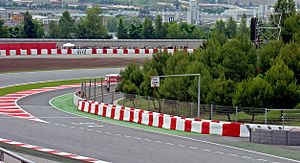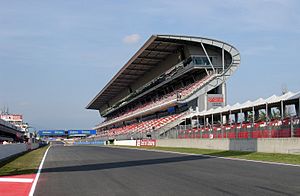Circuit de Catalunya facts for kids
 |
|
| Location | Montmeló, Barcelona, Catalonia, Spain |
|---|---|
| Time zone | GMT +1 |
| Major events | FIA Formula One Spanish Grand Prix FIM MotoGP Catalonian Grand Prix GP2, Spanish GT, DTM |
| Current | |
| Length | 4.655 km (2.875 mi) |
| Turns | 16 |
| Race lap record | 1:21.670 ( |
| 1991 Circuit | |
| Race lap record | 1:14.648 ( |
The Circuit de Barcelona-Catalunya is a famous racetrack located in Montmeló, a town just north of Barcelona, Catalonia, in Spain. It is well-known for hosting big races like the Formula One Spanish Grand Prix and the motorcycle Catalonia Grand Prix.
This track is considered an "all-rounder" because it has a mix of long straight sections and different types of corners. This makes it a great place for teams to test their cars and bikes before races. The circuit can hold many fans, with stands for over 140,000 people. It also has a special license from the FIA, which means it's a top-level racing venue.
Contents
History of the Circuit
The Circuit de Barcelona-Catalunya was built in 1991. It started hosting the Spanish Grand Prix in the same year. The track's construction was also timed with the Olympic Games held in Barcelona the following year. During the Olympics, the circuit was used as the start and finish line for the road team time trial cycling event.
Because racing teams do so much testing at this circuit, Formula One drivers and their mechanics know it extremely well. This has sometimes led to people saying that everyone is too familiar with the track. They believe this familiarity can make the races less exciting, with fewer overtakes.
When the track first opened, it was easier for cars to overtake. Drivers could follow closely through the last two corners and then use the long straight to pass. However, as car designs became more focused on aerodynamics, this changed. Cars found it harder to follow each other closely through fast corners because of the air turbulence created by the car in front.
To try and improve overtaking, a slow chicane (a tight set of turns) was added in 2007. This change replaced one of the fast final corners. However, this redesign has not made a big difference in the number of overtakes during Formula One races.
The Circuit de Catalunya also hosts many other exciting racing series, including Moto GP. Interestingly, the chicane added for Formula One races is not used for Moto GP events. In Moto GP, riders often overtake at least five different points on the track. Just like in Formula One, the first turn is the most popular spot for passing.
Track Layout and Challenges
One unique challenge at the circuit is the wind. The wind direction can change a lot throughout the day. This is a big deal for modern Formula One cars because their performance relies heavily on aerodynamics. A car might have too much drag or struggle with steering in the morning, but then have the opposite problem in the afternoon.
These changing conditions make it hard for teams to find the perfect setup for their cars. A type of tire that works well during testing might not perform as well a few months later during a race. This can lead to unexpected results from some teams during the race. The changeable wind has even caused accidents, like Fernando Alonso's testing crash in 2015, which was partly blamed on strong winds.
Exciting Races and Moments
The circuit has seen some truly memorable moments in racing history.
- In 1991, two legendary drivers, Ayrton Senna and Nigel Mansell, raced side-by-side down the entire front straight. Mansell eventually took second place and won the race.
- In 1994, Michael Schumacher managed to finish in second place even though he drove more than half the race with only fifth gear working!
- In 1996, Schumacher got his first win as a Ferrari driver. He put on an amazing show during a heavy rainstorm.
- The 1999 race was unusual because there was only one reported overtaking move during the entire event.
- In 2001, Mika Häkkinen was leading the race on the very last lap when his car had a clutch problem. This handed the win to Schumacher.
- At the 2006 event, Fernando Alonso made history by becoming the first Spanish Formula One driver to win at his home track.
In 2008, Heikki Kovalainen had a scary moment when his wheel failed at turn 9. He was going very fast, about 240 kilometers per hour (150 miles per hour), but managed to slow down to 130 km/h (80 mph) before hitting the tire barrier. He was briefly unconscious but thankfully gave a thumbs-up a few minutes later, letting everyone know he was okay.
At the 2009 motorcycle Grand Prix, teammates Valentino Rossi and Jorge Lorenzo had an incredible battle for first place. Rossi made a brilliant overtake on the very last corner to win. Riders and experts called the race "historic" and "genius."
Images for kids
See also
 In Spanish: Circuito de Barcelona-Cataluña para niños
In Spanish: Circuito de Barcelona-Cataluña para niños






